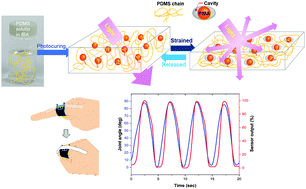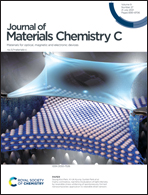Highly contrastive, real-time modulation of light intensity by reversible stress-whitening of spontaneously formed nanocomposites: application to wearable strain sensors†
Abstract
Stress-whitening is generally regarded as a sign of irreversible elasticity failure of polymer materials. Here, we report for the first time that in stark contrast to the conventional insight, the full range of stress-whitening occurs prior to a yield point and is even reversible, which can be applied to light intensity modulation. The reversibility of stress-whitening impeccably emerges in highly transparent nanocomposite films spontaneously formed during photocuring of poly(dimethylsiloxane-co-methylvinylsiloxane) solution in tert-butyl acrylate without any addition of nanofillers. This phenomeon is enabled by ‘elastic cavitation’ at soft elastomer matrix-hard nanoparticle interfaces. The film transmittance is readily controllable from ca. 80 to 0% under small strain (ε < 20%) due to a high population of the nanoparticles, high initial modulus difference and low compatibility between the matrix and particles. The ratio of transmittance change to strain is as high as 3.7–8.0 depending on the wavelength in the visible region. A highly sensitive wearable strain sensor is demonstrated as an application of the unprecedented phenomenon. Our optical strain sensor rapidly, repeatedly responds in transmittance and reflectance to strain of around 0–40% in accordance with human body motion. This work may initiate basic and technological research into various applications of the optically or electrically active element-free light intensity modulators which do not place limits on continuous shape-deformations.



 Please wait while we load your content...
Please wait while we load your content...